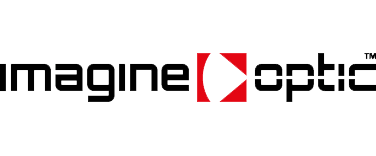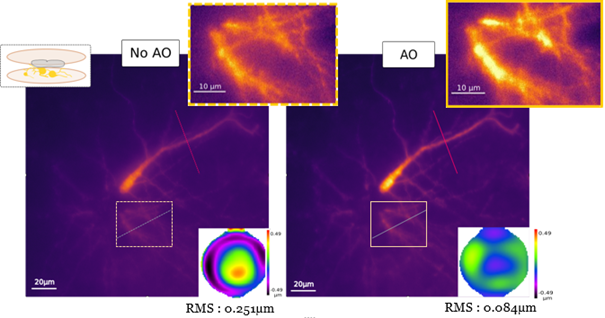Custom-designed Shack-Hartmann wavefront sensor enables accurate control of an adaptive optics loop in scattering conditions for the imaging of neuronal structures.
Adaptive Optics approaches in fluorescence microscopy
Although many Adaptive Optics (AO) approaches have been proposed in fluorescence microscopy, the presence of scattering deeper in biological samples, typically dictates the use of sensorless AO methods. In situations where scattering severely limits the use of a guide star, either based on fluorescent beads or involving a de-scan of fluorescence signal to enable the correction of optical aberrations, a classical Shack-Hartmann wavefront sensor cannot be used. However, sensorless AO – even if instrumentally simpler – provides a correction of aberrations at the cost of time-consuming iterative process of typically tens of seconds. Moreover, the quality of the correction is also driven by algorithmic parameters such as the choice of an adequate image quality metric.
Direct wavefront sensing for more accurate AO in microscopy
As a new step towards a faster and more accurate AO in microscopy even in scattering conditions, a team of researchers from Ecole Supérieure de Physique et de Chimie Industrielle (ESPCI, France), Ecole Normale Supérieure (ENS, France) and Imagine Optic recently proposed the use of an extended-source Shack-Hartmann wavefront sensor as a direct wavefront sensing device, which is more resilient to scattering than existing methods (full publication here). Even in low-signal to background conditions, a successful AO correction was demonstrated deep in the brain tissue in less than a second. Interestingly, researchers demonstrated that this device can also be used to quantitatively characterize the scattering properties of the sample.
As for all AO setups, the proposed method benefits from the almost perfect linearity of the wavefront corrector, in this case the Mirao 52e electromagnetic deformable mirror [FH1] , as well as from its high dynamic range and intrinsic achromaticity, e.g. considering its use in 2-photon microscopy setups. Keep posted to know more about our upcoming compact, high-resolution deformable mirror (µ-DM), that was recently presented here.
These results have been achieved in the frame of the INOVAO project (funding Agence Nationale de la Recherche, ANR-18-CE19-0002). #adaptive optics microscopy direct wavefront sensing

